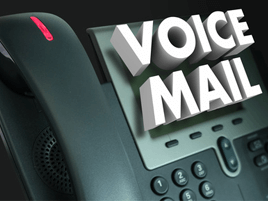
In many cases, your company’s voicemail greeting is the first point of contact with a new customer. Whether you’re looking to land a new client, or you’re servicing the needs of your existing customer base, it’s important to maintain a helpful and professional voicemail greeting. The right recording will contain all the essential elements of an efficient business voicemail within just a few seconds. Here’s how you do it.
Provide Essential Information First
Your voicemail greeting should open with all the essential information for your company. Identify your business immediately and let the caller know which department or individual they have reached. Include your title if you’re recoding a message for your personal voicemail. Close contacts may know who you are, but it’s important to let first-time callers know your exact job title, so customers don’t inadvertently leave details meant for a sales rep on the voicemail of an IT specialist or vice versa.
Putting this identifying information at the beginning of the message makes it easier for callers to hang up if they have the wrong number before wasting any more time on the line. Your message should also mention whether the office is open or closed so callers know if you’re simply away from your desk at the moment, or out of the office until the next business day.
Avoid Voicemail Cliches
Everyone has been routed to voicemail at some point, and it’s rarely a fun experience. At best, it’s a minor hassle. Minimize the frustration for the caller by eliminating any tired clichés that will only make the whole process seem that much more boring. Lines like “We’re sorry we can’t take your call right now,” and “Your call is very important to us,” are so overused they’ve lost their meaning. Don’t waste time on platitudes that should be assumed.
Choose a Tone that Conveys Your Corporate Culture
While it’s important to make your professional voicemail greeting short and to the point, it doesn’t have to be boring or boilerplate. Consider your overall corporate culture and infuse some of that in your message. This is particularly important if your company is known for having a culture that’s quirky, whimsical, or otherwise distinctive.
Be polite and informative, but don’t hesitate to add a little humor to a custom message if you can work it in. Any unexpected turn of phrase that makes your caller smile or chuckle will turn an ordinary call into a memorable experience, even when you’re not there to pick up the phone.
Explain the Next Step
The caller’s next step will vary depending on the type of voicemail they’ve reached. If you have an automated assistant that routes callers to various departments, your voicemail must explain the process for navigating this tree and finding the correct person.
In most cases, you’ll instruct the caller to leave a message. Briefly remind them what details to include. At a minimum, this should be their name and phone number. However, depending on your business you may also want more detailed facts, such as which software they use, which school district they’re with, or other identifiers.
Let the caller know when they can expect a response. If your phone system routes calls to your cell phone when you’re out of the office, you may be able to promise a response in a matter of hours. If your calls wait for you at the office, let callers know your business hours or typical response time. Include instructions for leaving urgent messages in the case of an emergency. This is particularly important if you’re in a medical field or provide emergency home repairs.
Keep it Brief
The perfect professional voicemail message will last between 20 and 25 seconds. This may not seem like much, but when you time yourself reading the appropriate information, you’ll probably find that you can say everything you need to in less than half a minute. If your message lasts much beyond this time frame, it’s time to trim it down.
Remember, you’ll make your real impression on the client when you promptly return their call. A voicemail isn’t the place for a long-winded rundown of your products and services. Treat your customer’s time as the valuable commodity that it is and keep your voicemail brief.
A well-crafted professional voicemail message gives your caller all the information he or she needs without bogging the recording down with unnecessary details. Include only those points that are relevant to all, or nearly all, callers, and you’ll have an efficient message that leaves a pleasant impression with any caller that you miss.


